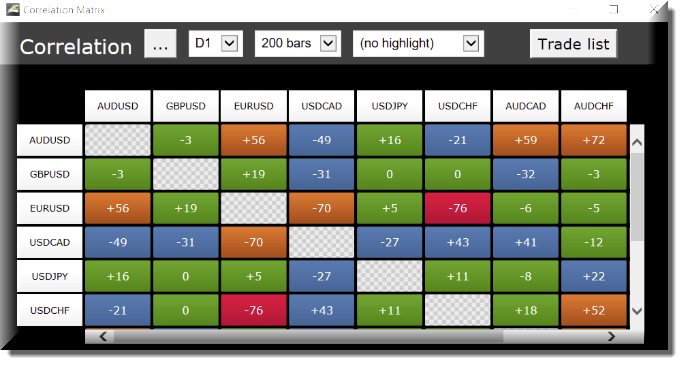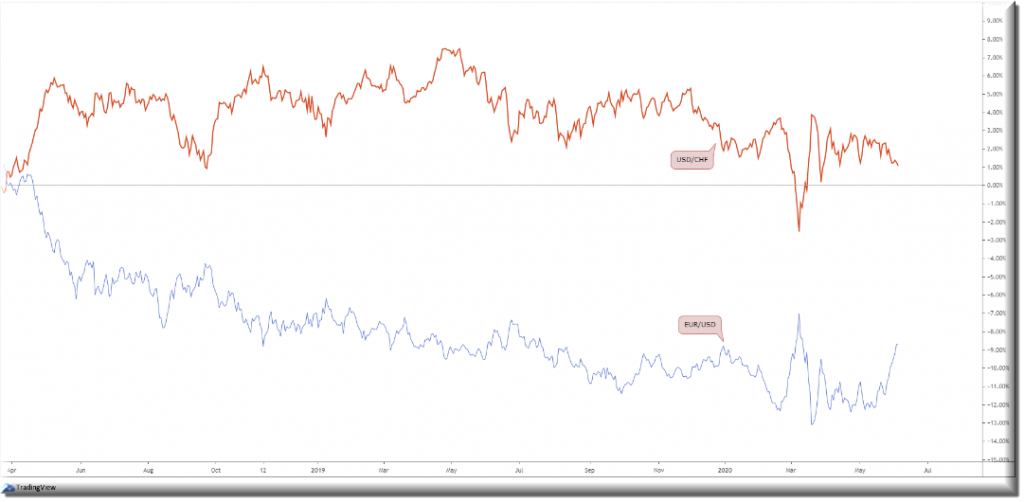Updated June 2020
According to the Triennial Central Bank Survey[1], trading in FX markets reached $6.6 trillion per day in April 2019, up from $5.1 trillion three years earlier. The US dollar retained its dominant currency status, being on one side of 88% of all trades. The share of trades with the euro on one side expanded somewhat, to 32%. By contrast, the share of trades involving the Japanese yen fell some 5 percentage points, although the yen remained the third most actively traded currency (on one side of 17% of all trades).
EUR/USD, therefore, is considered a major currency pair, a term used to label the most heavily traded currency pairs in the world.
Those unaware of how currency pairs are organised, the euro, in this case, is a base currency which always represents one unit. The US dollar, in EUR/USD, represents the counter currency, or quote currency. The value of the currency pair fluctuates daily, communicating the cost (in USD) to purchase a single unit of euro.
Central Banks
Regardless of one’s relationship with the financial markets, the majority know, or have at least heard of, the Federal Reserve, or more commonly referred to as ‘the Fed’. This is the central bank for the US.
Located in Washington DC, the Board of Governors provides leadership for the Fed system, responsible for the discount rate and reserve requirements. The Federal Open Market Committee, or FOMC, is the Fed’s monetary policymaking body, responsible for open market operations by way of three primary tools: open market operations, the discount rate and reserve requirements. The FOMC meet eight times per year.
Traders and investors pay particular attention to central bank movement as it can generate rapid intraday fluctuations and medium/long-term trending action.
While the Fed commands respect, it’s not the only institution to affect currency markets, in particular the EUR/USD. The European Central Bank, or ‘ECB’, headed by President Christine Lagarde and the Vice-President Luis de Guindos, sets and implements monetary policy for the Eurozone.
Economic Influences
While US and European central bank movement is important, so is macroeconomic data.
In fact, in order to develop the nation’s monetary policy (the action a country’s central bank or government employs to influence how much money is in the economy and how much it costs to borrow), central banks watch a number of key economic indicators.
These same indicators can cause the EUR/USD to fluctuate, sometimes wildly. Below are some of the key readings central banks keep a close eye on.
Inflation.
Inflation refers to the rate at which prices for goods and services rises. If inflation continues to climb (CPI and PCE indexes) this may spur central banks to hike interest rates. What this does is make things more expensive and therefore generally slows consumer spending. By the same token, deflation will likely see central banks lower interest rates in an attempt to encourage spending.
Real Gross Domestic Product (GDP).
The GDP denotes the total of all goods produced. Data, in the US, is released quarterly and represents output using real terms – inflation doesn’t distort the numbers.
It is used as an indicator of the performance and growth of the economy.
Employment.
Employment, in the US for example, offers insight into the state of the world’s largest economy, considered a leading indicator of consumer spending.
The aftermath of the monthly US non-farm payrolls report generally produces a sizeable reaction on EUR/USD.
Employment numbers for the Eurozone’s major economies such as Germany and France should also be underscored.
Correlation
Currency pairs often correlate, displaying a clear relationship.
The correlation coefficient gauges the strength between two markets.
There are several ways of calculating correlation, though the most popular is Pearson’s correlation coefficient.
The correlation coefficient varies between -1 and +1. A value of +1 indicates a strong linear relationship between two currency pairs, facing a northerly trajectory. A reading of -1, however, suggests a linear relationship, negatively sloped. If the coefficient value is 0, correlation is random.
The Correlation Matrix (figure A) is a handy tool, showing the correlation between selected symbols:
(FIGURE A)
Correlations can provide an additional edge to your trading strategy and also hedge exposure to risk.
For example, a long position on USD/CHF to hedge possible loss on an active long EUR/USD position is an option, given the currency pairs boast strong historical negative correlation, as shown via the line chart in figure B.
(FIGURE B)
Although two individual currencies can indeed exhibit a certain correlation due to their specific fundamental characteristics, there will be times correlations deviate. This is usually due to political or economic reasons.
Active Hours
Although EUR/USD trades 24 hours a day five days a week, it is not always active.
The pair tends to gain traction heading into the London open. Momentum typically continues throughout London, and follows into the US segment. However, the pair tends to slow down somewhat during the US afternoon.
The accuracy, completeness and timeliness of the information contained on this site cannot be guaranteed. IC Markets does not warranty, guarantee or make any representations, or assume any liability regarding financial results based on the use of the information in the site.
News, views, opinions, recommendations and other information obtained from sources outside of www.icmarkets.com.au, used in this site are believed to be reliable, but we cannot guarantee their accuracy or completeness. All such information is subject to change at any time without notice. IC Markets assumes no responsibility for the content of any linked site.
The fact that such links may exist does not indicate approval or endorsement of any material contained on any linked site. IC Markets is not liable for any harm caused by the transmission, through accessing the services or information on this site, of a computer virus, or other computer code or programming device that might be used to access, delete, damage, disable, disrupt or otherwise impede in any manner, the operation of the site or of any user’s software, hardware, data or property.



